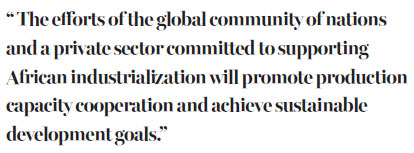Africa's open road to development
Continent positioned to become the next major manufacturing hub in the global marketplace
Our world is coming off an incredible 2016. If the United Kingdom's vote for Brexit wasn't bad enough, Donald J. Trump will be sworn as president of the United States in January.
And Africa's year hasn't been so rosy either. From protests in Ethiopia and the Democratic Republic of the Congo, to deepening economic turmoil in Nigeria and South Africa, to ongoing humanitarian crises across the continent, Africa has probably more reasons to mourn than rejoice in 2016.
Yet there may be a glimmer of hope. Key stepping stones on Africa's path to industrialization were laid firmly in 2016, creating an important opportunity: The continent can become the next manufacturing hub for the global market.


The Made in Africa Initiative aims to help the continent seize the opportunity for industrialization arising from the pending relocation of light manufacturing from China and other developing market economies. By capturing this opportunity, Africa will achieve sustainable, dynamic and inclusive growth.
However, today's Africa faces serious challenges. What Africa needs now are success stories to provide the aspirations, confidence and experience necessary for it to realize its potential in terms of industrialization and shared prosperity. The Made in Africa Initiative offers a vision to create success in African countries.
The opportunities
Modern economic growth, highlighted by a continuous rise in a country's per capita income, is a process of ever-increasing labor productivity. Making this process possible are continuous structural transformations in technologies and industries - to reduce the factor costs of production and increase output values; and in infrastructure and institutions to reduce transaction costs and risks.
Why have African countries failed to prosper? Because they have not transformed their economic structures from agriculture and mining to modern industry. However, from our perspective, poverty and backwardness is not destiny for African countries. The future can change if Africa seizes the golden opportunity of industrialization.
The developed high-income countries of Europe and North America all started to transform their humble, premodern agrarian economies by developing light manufacturing. The few economies in East Asia catching up to the developed countries after World War II jump-started their industrialization by entering light manufacturing because of rising wages in the higher-income countries. Consider the relocations from the United States to Japan in the 1950s, from Japan to the four Asian Tigers - Hong Kong, Taiwan, Singapore, and South Korea - in the 1960s, and from the four Asian Tigers to the Chinese mainland in the 1980s.
China is now at a stage - like that of Japan in the 1960s and the Four Tigers in the 1980s - to begin relocating its light manufacturing to other countries because of its rapidly rising labor costs. Growth in China and in other emerging market economies, such as India and Brazil, will again provide opportunities for other developing countries to jump-start their industrialization.
Africa is potentially an attractive destination for the relocation of light manufacturing from China and other developing market economies. Africa has an abundant supply of young labor. It is close to European and the US markets. And it has zero tariffs on its exports, thanks to the Africa Growth Opportunity Act in the US and the EU's Everything But Arms policy.
The Made in Africa Initiative aims to help Africa exploit this window of opportunity to become the world's next manufacturing hub and to achieve dynamic, sustainable and inclusive growth.
The challenges
To capture this opportunity, African countries faces several challenges that needs to be tackled in the near future:
Lack of technological know-how - how to produce high-quality goods at a competitive price in the global market by using abundant labor and other resources.
Lack of confidence by international buyers in the ability of African manufacturers to deliver goods on time and with the consistent quality specified in contracts.
Lack of infrastructure and a business environment to reduce the transaction costs in reaching international markets.
How can an African country best overcome these challenges?
First, the government must adopt an active investment promotion strategy to attract existing export-oriented light manufacturing companies that have the technological know-how and enjoy the confidence of international buyers in China and other emerging market economies.
Second, governments must use their limited resources and implementation capacity strategically to establish industrial parks and special economic zones with adequate infrastructure and a good business environment to help investors reduce their transaction costs.
A new mission
The Made in Africa Initiative will help African countries generate quick successes in export-oriented light manufacturing through a strategy that includes the following:
Bridging the information gap to help export-oriented light manufacturing enterprises in China and other emerging market economies understand Africa's advantages and set up production there.
Engaging with stakeholders and connecting with policymakers, development agencies, businesses communities and other key parties, globally, regionally and nationally, to share the vision and the approach for capturing Africa's window of opportunity to industrialize.
Advocating triangular collaboration to connect the dots. Advocate win-win cooperation between African countries and prospective investors, such as international retailers in Europe and the US, presenting the comparative advantages in abundant supplies of labor and raw materials.
Working with international organizations and world leaders in the global supply chain to connect the dots of triangular collaboration (manufacturing capability, global retail market and African comparative advantages).
Supporting African countries in identifying their comparative advantages and creating their own development approach, as well as providing intellectual support to African countries to identify their sectors of comparative advantage.
Sharing successes and failures of past industrialization efforts, and support African countries in developing an approach that is green, inclusive, sustainable and environmentally friendly.
Working with governments, including national leaders, to build quick key success examples in industrial development.
Bringing prospective investors who have the manufacturing know-how to visit African countries to facilitate early-stage investment negotiations with the government and to ensure successful investments and implementation to turn the country's opportunities into reality.
Identifying policy constraints through the first movers' operations, and advising the government on further reforms to attract more international and domestic manufacturing investment.
Africa's future
As we believe that the best way to develop a country's economy is to upgrade and diversify its industries by clearly identifying its latent comparative advantages, we see more African countries recognizing the right path to industrialization.
More important, Africa's future prosperity can be foreseen. The efforts of the global community of nations and a private sector committed to supporting African industrialization will promote production capacity cooperation and achieve sustainable development goals through the application of top-level technical expertise and other available tools.
After all, poverty is not destiny.
The author is chief executive officer, Made in Africa Initiative. The views do not necessarily reflect those of China Daily.


















